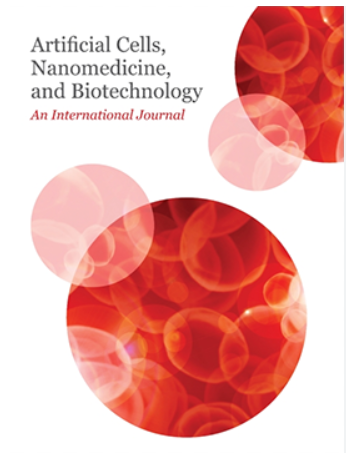水凝胶载体中萘普生-磺胺吡啶反式杂化复合物:完全弗氏佐剂诱导的关节炎大鼠的抗炎反应
IF 4.5
3区 生物学
Q1 BIOTECHNOLOGY & APPLIED MICROBIOLOGY
Artificial Cells, Nanomedicine, and Biotechnology
Pub Date : 2022-03-09
DOI:10.1080/21691401.2022.2047712
引用次数: 5
摘要
目前,类风湿关节炎(RA)的治疗主要采用抗风湿药物、非甾体类抗炎药物或其联合用药来减轻关节炎症。本研究以PL90G和胆固醇为原料,采用薄膜水合技术制备萘普生(NAP)和磺胺吡啶(SULF)质体,并与carbopol®934交联。对所制备的脂质体和脂质体水凝胶进行了流变性、理化分析和体内体外研究。结果表明,NAP和SULF质体的平均囊泡大小分别为251.1±1.80 ~ 343.5±3.23 nm和269.0±1.17 ~ 358.8±1.22 nm,具有良好的稳定性(zeta电位> 30 mV)和多分散性指数。差示扫描量热仪和傅里叶变换红外研究表明,溶酶体的药物性质没有明显变化。透射电镜分析显示200 nm以下的球形囊泡。NAP和SULF酶体的包封效率均在66%以上,NAP-SULF酶体-水凝胶(EH)具有缓释作用(>8 h)。在体内实验中,NAP-SULF EH对诱导性关节炎Wistar大鼠的炎症有显著的抑制作用(84.63%),其足部体积(0.1935±0.08 ml)较小(p < 0.01)。NAP-SULF EH在25°C±0.5下稳定3个月。综上所述,水凝胶载体中NAP-SULF的混合复合物可有效预防炎症,可能是RA药物转运的新途径。图形抽象本文章由计算机程序翻译,如有差异,请以英文原文为准。
Trans ethosomal hybrid composites of naproxen-sulfapyridine in hydrogel carrier: anti-inflammatory response in complete Freund’s adjuvant induced arthritis rats
Abstract Current treatment for Rheumatoid arthritis (RA) utilizes Disease-modifying antirheumatic drugs, non-steroidal anti-inflammatory drugs or its combination, to decrease joint inflammation. In the present study, naproxen (NAP) and sulfapyridine (SULF) ethosomes were prepared by a thin-film hydration technique using PL90G and cholesterol, later crosslinked with carbopol®934. The ethosomes and ethosomal hydrogel were evaluated for rheological properties, physico-chemical analysis, in vitro and in vivo study. The results show, NAP and SULF ethosomes exhibited an average vesicle size between 251.1 ± 1.80–343.5 ± 3.23 nm and 269.0 ± 1.17–358.8 ± 1.22 nm, respectively, with good stability (zeta potential > 30 mV) and polydispersity index. Differential scanning calorimeter and Fourier transform infrared studies reveal no significant changes in the drug properties of ethosomes. Transmission electron microscopy analysis discloses spherical shape vesicles below 200 nm. The entrapment efficiency of NAP and SULF ethosomes was above 66%, and NAP-SULF ethosomes-hydrogel (EH) exhibited a sustained release effect (>8 h). In vivo studies on NAP-SULF EH shows significant inhibition of inflammation (84.63%), with less paw volume (0.1935 ± 0.08 ml) on induced arthritis Albino Wistar rats, (p < .01). NAP-SULF EH was stable at 25 °C ± 0.5 for 3-months. To conclude, a hybrid composite of NAP-SULF in hydrogel carrier prevents inflammation effectively, and could be novel for trans delivery of drugs in RA. Graphical Abstract
求助全文
通过发布文献求助,成功后即可免费获取论文全文。
去求助
来源期刊

Artificial Cells, Nanomedicine, and Biotechnology
BIOTECHNOLOGY & APPLIED MICROBIOLOGY-ENGINEERING, BIOMEDICAL
CiteScore
10.90
自引率
0.00%
发文量
48
审稿时长
20 weeks
期刊介绍:
Artificial Cells, Nanomedicine and Biotechnology covers the frontiers of interdisciplinary research and application, combining artificial cells, nanotechnology, nanobiotechnology, biotechnology, molecular biology, bioencapsulation, novel carriers, stem cells and tissue engineering. Emphasis is on basic research, applied research, and clinical and industrial applications of the following topics:artificial cellsblood substitutes and oxygen therapeuticsnanotechnology, nanobiotecnology, nanomedicinetissue engineeringstem cellsbioencapsulationmicroencapsulation and nanoencapsulationmicroparticles and nanoparticlesliposomescell therapy and gene therapyenzyme therapydrug delivery systemsbiodegradable and biocompatible polymers for scaffolds and carriersbiosensorsimmobilized enzymes and their usesother biotechnological and nanobiotechnological approachesRapid progress in modern research cannot be carried out in isolation and is based on the combined use of the different novel approaches. The interdisciplinary research involving novel approaches, as discussed above, has revolutionized this field resulting in rapid developments. This journal serves to bring these different, modern and futuristic approaches together for the academic, clinical and industrial communities to allow for even greater developments of this highly interdisciplinary area.
 求助内容:
求助内容: 应助结果提醒方式:
应助结果提醒方式:


